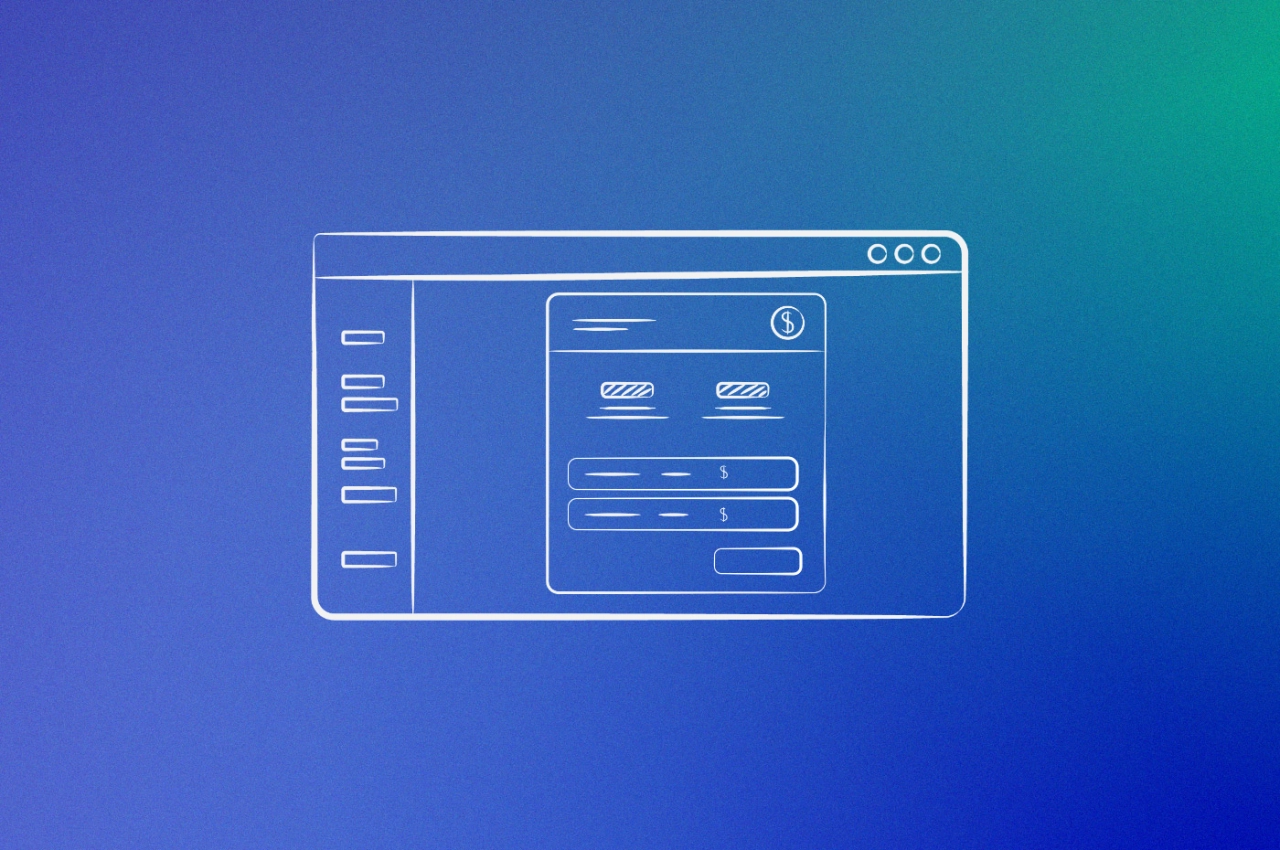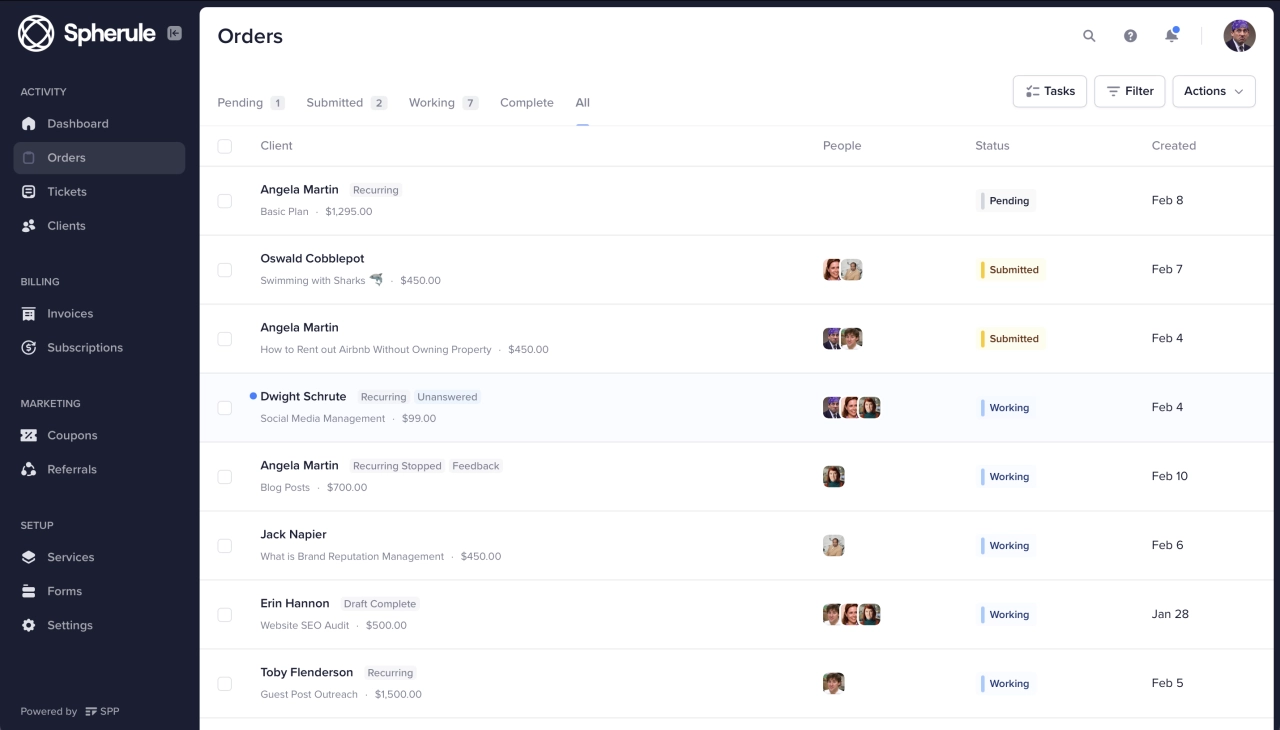- Project-based pricing can be an effective pricing strategy for service businesses, as it allows them to tailor their pricing to the specific needs of each project and avoid the potential downsides of hourly or fixed pricing models.
- Project-based pricing offers several benefits to service businesses, including increased transparency, improved cash flow, and the ability to more accurately estimate project costs and profitability.
- To effectively use project-based pricing, service businesses should carefully evaluate each project, clearly define the scope of work, communicate expectations with the client, and implement effective project management strategies.
Whether you’ve been in business for years or you’re just starting, pricing is one area you need to get right. Charge too high, and you scare potential customers away. Charge too low, and your product or service is perceived as low-quality.
But with different types of pricing strategies to choose from, how do you find a balance to ensure you’re not only profitable but also attracting the right clients?
One pricing model that solves this conundrum is project-based pricing (PBP). At SPP, we work with various agencies using this pricing model to great effect.
In this article, you’ll learn more about project-based pricing, its benefits, and some real-life examples of this model in action. I’ll also share some factors to consider and best practices to adopt when choosing PBP for your agency.
What is project-based pricing?
PBP is a pricing model where you charge a fixed fee for completing a specific project or service. It’s a common pricing strategy among freelancers and small business owners in niches such as software development, web design, graphic design, content writing, and digital marketing.
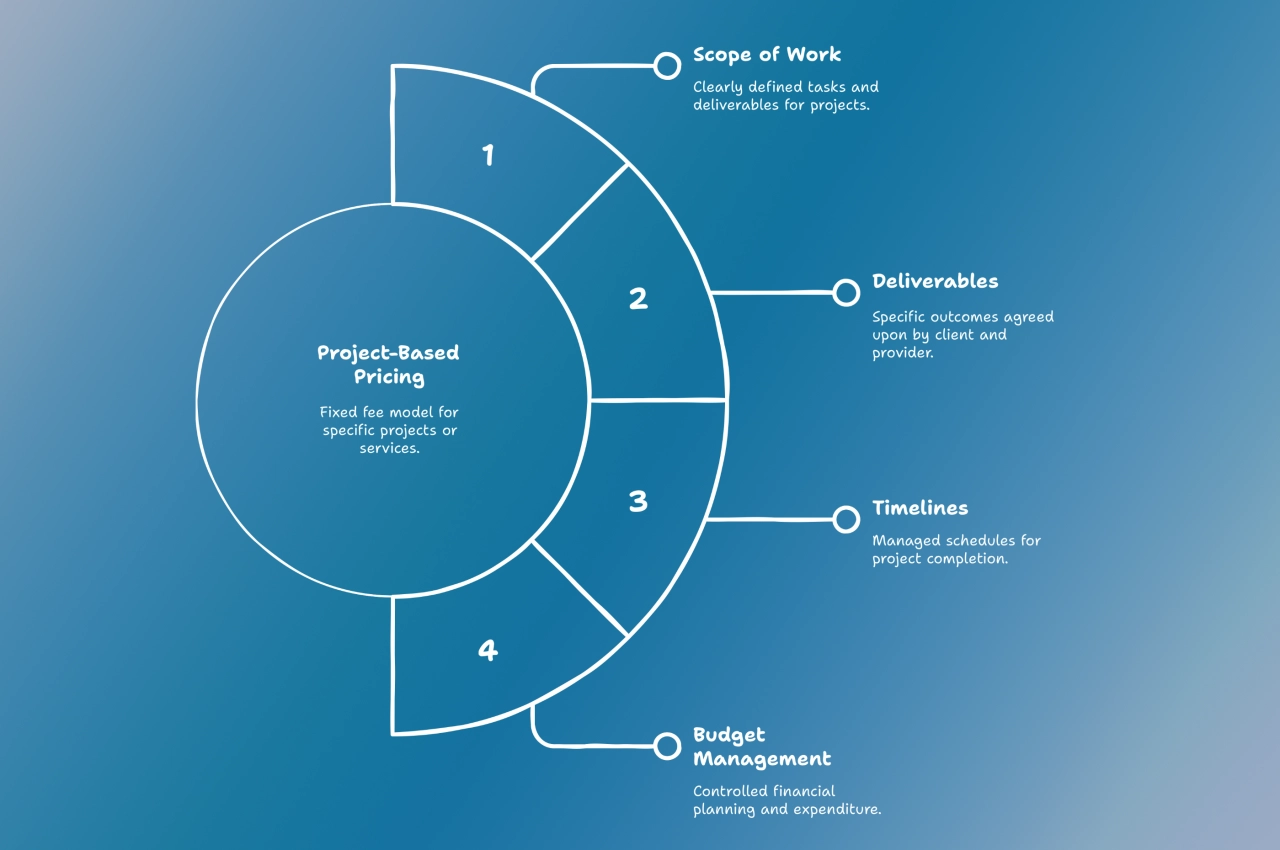
In PBP, both the client and service provider agree on a flat rate for projects based on a clearly defined scope of work and deliverables. This makes it easier to manage timelines and budgets.
Benefits of project-based pricing
Project-based pricing offers several powerful advantages for service businesses that can transform not only how you charge clients but also how you manage projects, plan your finances, and scale your agency.
1. Flexibility to customize projects
Since prices are charged based on individual projects, a project-based pricing strategy gives room for more flexibility to customize projects based on clients’ needs. Some projects have unique requirements, which means a one-size-fits-all approach won’t work.
This type of pricing allows you to provide each client with a unique quote that takes into account their specific needs and factors like the complexity of the project, the time and effort it will take, etc.
It allows you to set clear expectations upfront, which leads to better working relationships with clients.
For example, client A wants to build a simple website with few pages and basic functionality whereas client B wants a website with complex functions like inventory management, payment gateway, etc.
What you charge client B will be more than what you charge client A due to the extra features involved in the project.
2. Helps you plan your finances ahead
When it comes to pricing, the retainer model is very popular with agencies—not so much with their clients. Still, as a business owner you want to plan ahead and allocate resources, which is why this pricing method is popular.
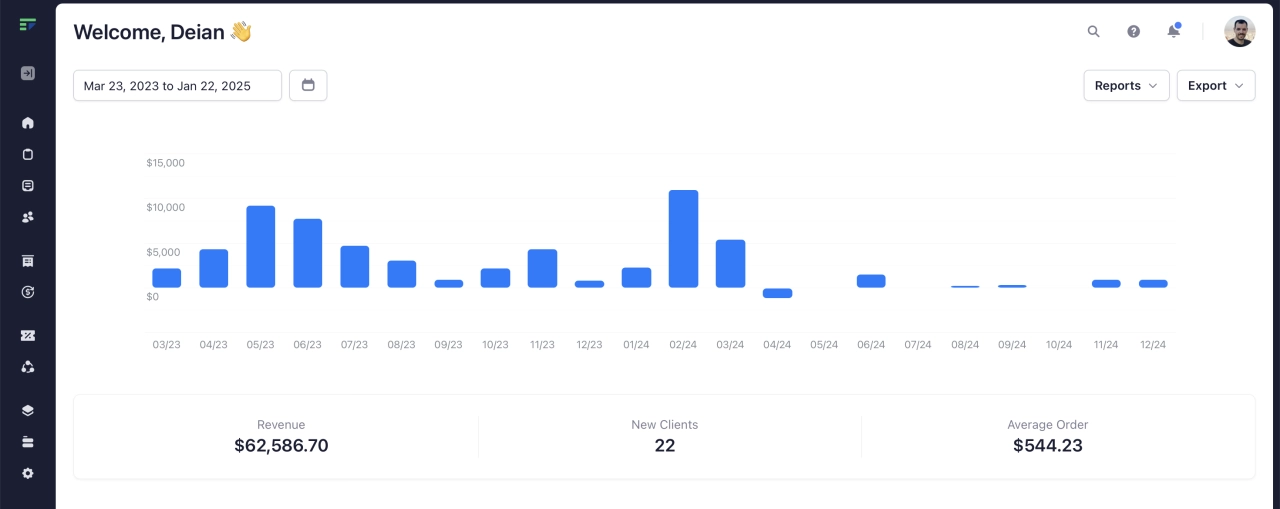
Agreeing on a flat rate with clients upfront means you know how much you’ll receive for your services. It helps you to plan your finances and manage your cash flow more effectively. Unlike charging hourly rates where you are not sure how much you’ll be paid after completing the project.
3. Reduces scope creep
In a project-based pricing model, you and the client agree on a specific scope of work, outlining what needs to be done, the completion date, and the cost.
It reduces the risk of scope creep, where the project expands beyond what was initially agreed upon, leading to additional costs and delays.
Having a clear understanding of the project requirements and timelines can help you manage your time and resources more efficiently. It also ensures you have the necessary resources in place to deliver the project on time and within budget.
4. Promotes transparency
Clients know exactly what they are paying for since the price is agreed upon before the start of the project. So regardless of how long you spend on it, there won’t be any hidden fees.
If for any reason the client needs to pay more, you’re expected to communicate this clearly and promptly before sending the invoice. It will help avoid any disputes that may arise when it’s time to make payment.
Project-based pricing examples
As we’ve already established, the pricing on a per-project basis is determined by several factors, including the scope of the project, timeline, and resources required. Let’s take a look at four PBP examples:
Social media marketer: if you offer social media marketing services, you may charge a flat fee for managing social media accounts. You could also charge additional fees for managing multiple social media accounts, creating a social media strategy including a content calendar, and creating monthly analytics reports.
Web developer: let’s say you charge $5,000 for building websites with animations. Clients who require more complex functionalities will be charged extra fees. For instance, adding an e-commerce store to a website can attract additional charges because it requires extra resources like merchant accounts and payment gateways.
Content marketer: most freelance writers can price their services on a per-project basis or the word count. For instance, a writer can charge $0.5 per word or $500 for an article. Clients that require additional services like content strategy, content distribution, and SEO will pay extra.
Software developer: software companies charge based on the complexity of the project, the number of features, and the resources needed. For example, a basic mobile app with minimal features like a contact form will be cheaper than an app with complex features such as integrations with external services, data management, and security.
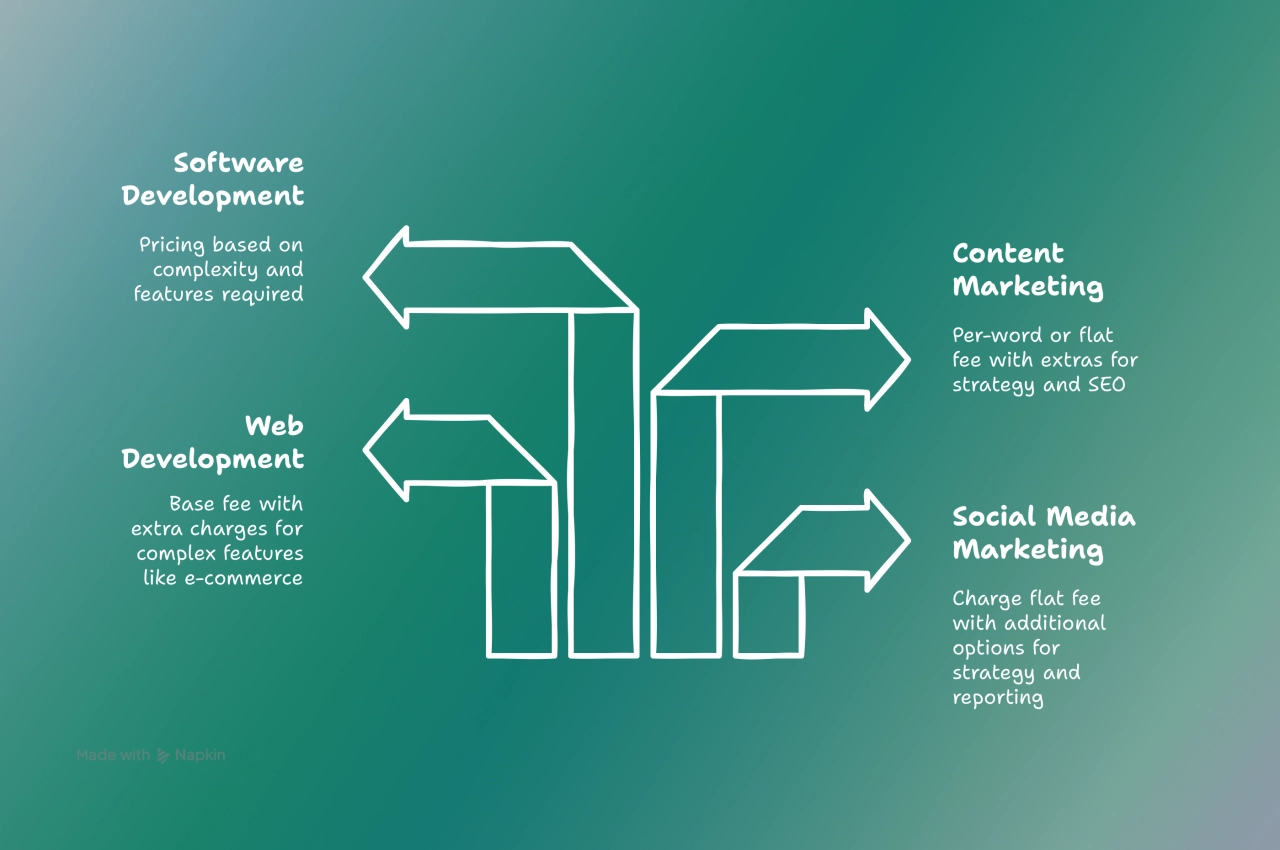
Understanding the project’s scope, timeline, and resources required helps you determine a fair and profitable price for your services while delivering customized solutions that meet your client’s expectations.
Pricing model comparison
Choosing the right pricing model for your service business can feel overwhelming. Should you charge hourly? Per project? On retainer? The answer depends on your specific situation, project types, and growth goals.
I’ve worked with hundreds of agencies through SPP.co, and I’ve seen firsthand how the right pricing model can transform a struggling business into a profitable one.
Let’s break down the main options so you can make an informed decision.
Pricing Model | Best For | Pros | Cons | Example Scenario |
|---|---|---|---|---|
Project-based | Well-defined projects | Predictable revenue for your business | Requires accurate scoping skills | Web design agency charges $7,500 for an e-commerce site with defined features. Payment: 50% upfront, 25% at midpoint, 25% upon completion. |
Hourly | Complex projects with unclear scope | Fair compensation for all time spent | Unpredictable final costs for clients | Development agency charges $150/hour for custom programming. CRM integration costs range from $3,000-$6,000 depending on discovered complexity. |
Retainer | Ongoing services with regular deliverables | Stable, predictable recurring revenue | Potential for scope creep | Social media agency charges $2,500/month to manage 3 platforms with 15 posts monthly. 6-month minimum commitment. |
Value-based | High-impact services with measurable ROI | Potentially highest profit margins | Difficult to implement | SEO agency charges $10,000 base fee plus 10% of additional revenue generated from traffic increases over 12 months. |
Which pricing model should you choose?
Not sure which model fits your business? Ask yourself these questions:
How accurately can you scope your projects? If you’ve delivered similar projects many times and can confidently estimate resources needed, project-based pricing probably makes sense. If you’re often surprised by unexpected complications, hourly might be safer until you gain more experience.
What do your ideal clients prefer? Enterprise clients often prefer fixed project pricing for budget approval. Smaller businesses might prefer the transparency of hourly rates. With SPP.co, we’ve seen agencies offer multiple pricing options to appeal to different client segments.
What are your growth goals? Project-based pricing tends to be more scalable as your team grows, while hourly pricing can create a revenue ceiling based on available hours. Retainers provide stability for planned growth, while value-based pricing can dramatically increase your profit margins.
How mature is your service offering? New services might work better with hourly pricing until you understand the true costs. Well-defined, repeatable services are perfect for project-based pricing. Strategic services with measurable results are candidates for value-based pricing.
When project-based pricing makes the most sense
Project-based pricing works particularly well when:
you deliver the same type of service repeatedly
you can define clear deliverables and outcomes
you have historical data on how long projects take
your clients need budget certainty
you want to reward your team’s efficiency
you’re looking to scale beyond trading hours for money
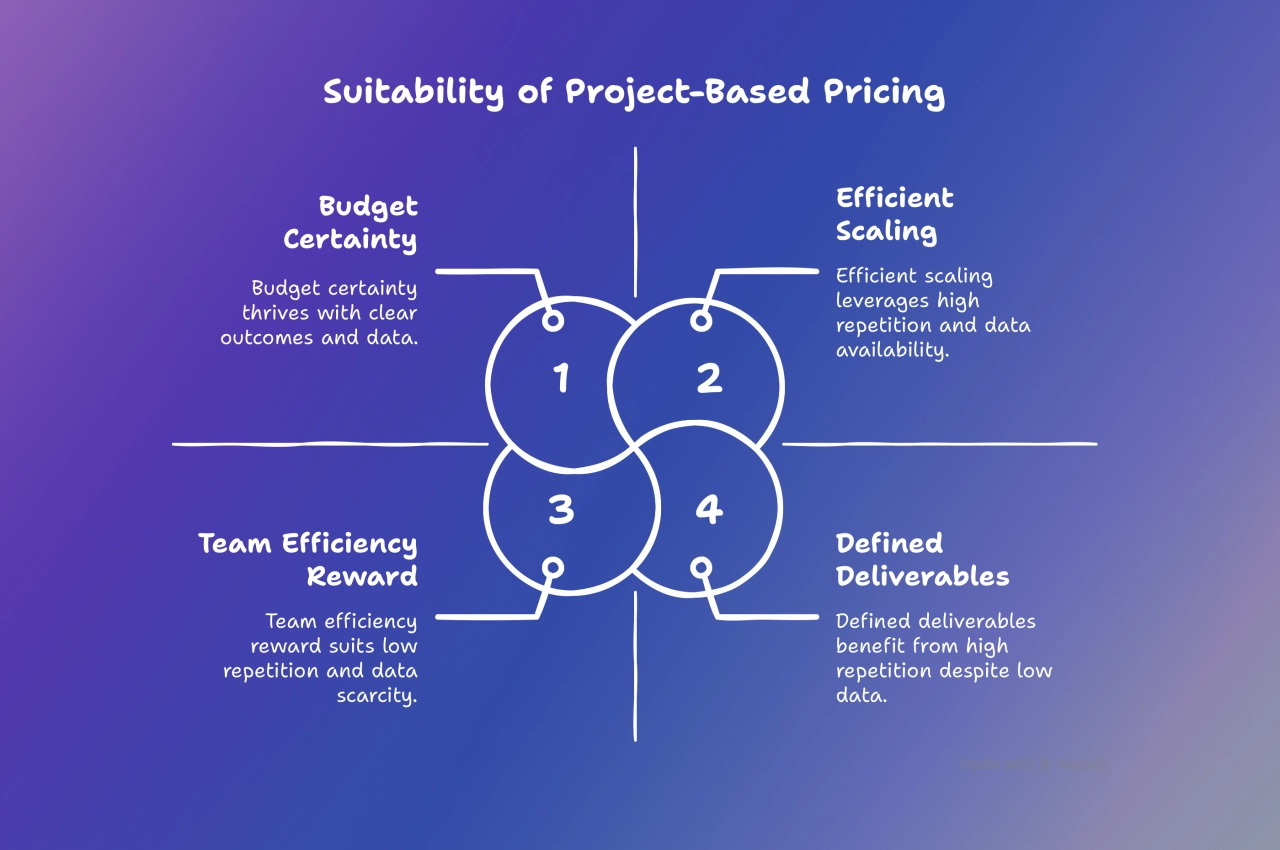
Don’t worry if you’re currently using a different pricing model. The transition to project-based pricing can be gradual, starting with just one service offering while you build confidence in your scoping and estimation skills.
Herein lies the real advantage of project-based pricing—when implemented correctly, it creates a win-win situation where clients get cost certainty while you maintain healthy profit margins by improving your processes and efficiency.
Factors to consider for project-based pricing
Setting a price per project is influenced by many factors. That’s why it’s advisable to try other pricing types, like hourly pricing or the fixed cost pricing model to understand the amount of time and resources that go into each task before setting a fixed price.
But if you choose to jump straight into pricing per project, here are some relevant factors to consider before setting a price.
Timelines and deadlines
Although time is not a major factor when it comes to pricing on a per-project basis, it’s important to work with timelines and deadlines.

This will help determine the number of projects you can handle within a specified period and the amount it will cost to complete each one. More complex projects will take longer and should cost more.
Resources required
Some projects require more resources than others, especially when your clients make special demands. As such, it’s essential to consider the resources required going into each project and their accessibility before giving a price.
We try to expect the unexpected as best we can. We build in buffers for every project to accommodate edge cases but, for larger demands, we’re able to shift priorities, tag in team members with available capacity, or even bring on contractors if needed.
 Maxwell DesMarais,
Vital Design
Maxwell DesMarais,
Vital Design
Ideally, a project that requires more resources will attract a higher price than a project that demands fewer resources. For example, a website that requires a payment gateway will require more resources and therefore cost more than one that doesn’t.
Industry rates
Like other pricing models, surveying the industry to check how much your competitors charge per similar project will give you a clue on how you should charge. This factor is crucial so you don’t undervalue your services or charge too high to avoid scaring away potential clients.
It’s a combination of factors. Vital’s been around for over 20 years, so we have a substantial amount of internal historic data to draw from when pricing projects, but we absolutely keep a close eye on industry benchmarks and how our competitors are pricing their offerings, as well.
 Maxwell DesMarais,
Vital Design
Maxwell DesMarais,
Vital Design
Remember, your level of experience is also a factor you should consider when comparing prices to determine yours.
The project’s complexity
Generally, a complex project will require more resources and time. Other factors can include hiring more hands to complete specific tasks. All these contribute to the project’s complexity, thereby impacting the project’s price.
We take a collaborative approach to scoping these kinds of projects, bringing in different department directors to weigh in and work together. In some cases, we'll even run a preliminary discovery project to identify exactly what the client’s need is and how we can accommodate it, then plan accordingly.
 Maxwell DesMarais,
Vital Design
Maxwell DesMarais,
Vital Design
Demand and supply
Demand and supply have a profound impact on all pricing models. According to the basic rule of supply, the higher the demand for a particular service, the higher the price.
Now that you know some factors to consider when setting prices, here are some best practices of PBP.
Transitioning to project-based pricing
Making the switch from hourly to project-based pricing doesn’t happen overnight. With a thoughtful approach, you can transition smoothly while bringing your clients along for the journey.
Before setting project prices, dig into your historical data:
Review completed projects from the past 12 months and categorize them by type, complexity, and client industry.
Calculate the actual hours spent on each project, breaking them down by task type (design, development, revisions, project management, etc.).
Identify patterns and outliers — which projects took significantly longer than expected and why? Which were most profitable?
Determine your effective hourly rate by dividing project revenue by hours spent. This reveals which projects were actually profitable.
Document scope creep instances and calculate their impact on your bottom line.
Create project templates based on your findings, grouping similar projects and establishing baseline scopes and timelines.
Set standard pricing tiers using your historical data, adding appropriate margins for profit and unexpected contingencies.
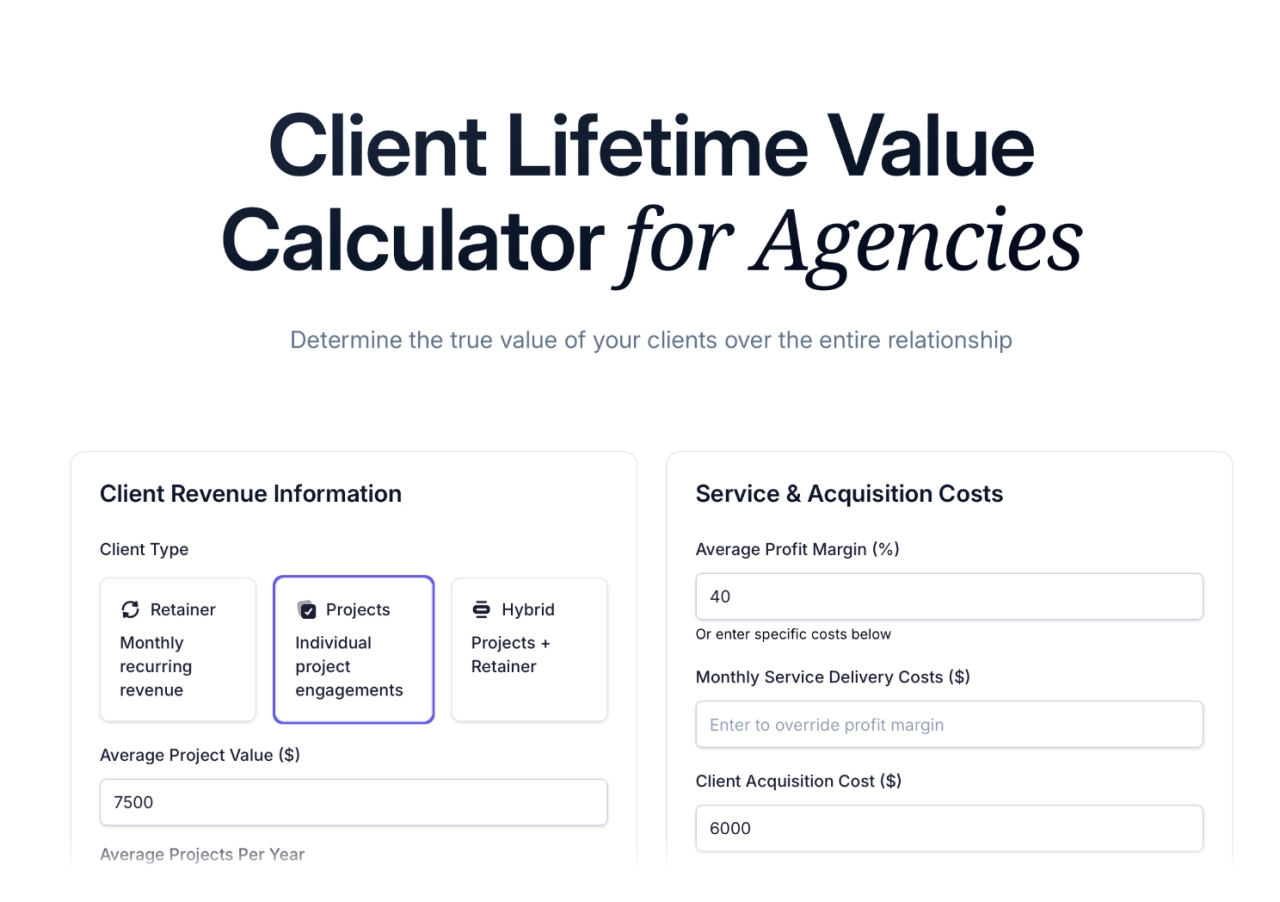
Calculate your client lifetime value.
With SPP.co, you can analyze your past project data in the reporting section, making this process much more straightforward.
Preventing scope creep
One thing I didn’t include in the previous factors section is scope creep. It’s such a big and complicated topic that I wanted to give it more attention.
Ever started a project that seemed perfectly defined, only to find yourself doing twice the work for the same pay? That’s scope creep in action, and it’s one of the biggest profit killers for agencies using project-based pricing.
Let’s look at how you can prevent scope creep from eating into your margins while maintaining strong client relationships.
Sample client communication scripts
Clear communication from the start sets the right expectations. Here are scripts you can adapt for different project stages:
During the proposal stage:
This proposal covers [specific deliverables]. Any additional features or revisions beyond what’s outlined here will require a change order. This ensures we can maintain the agreed timeline and quality standards while accommodating your evolving needs.
When kicking off the project:
I’ve attached our scope document outlining everything we’ve agreed to deliver. Please review it carefully and let me know if you have any questions. Once approved, this will be our roadmap for the project, and any changes to it will need to go through our change request process.
When a client requests something outside scope:
I understand you'd like to add [requested feature]. Since this wasn’t part of our original agreement, I’ll need to create a change order that outlines the additional cost and timeline impact. This helps us both keep track of how the project is evolving and ensures we can allocate the right resources to maintain quality.
Red flag indicators
Some client behaviors and requests often signal impending scope creep. Watch for these warning signs:
Vague requirements: I'll know what I want when I see it
Frequent small additions: Can you just add this one small thing?
Moving goalposts: This looks good, but now I think we need…
Stakeholder expansion: New decision-makers joining mid-project
Benchmark shifts: I just saw our competitor doing X; we should add that
Approval hesitation: Reluctance to sign off on completed phases
Feature envy: Sending you links to features from other projects
When you notice these patterns, address them immediately rather than hoping they’ll resolve themselves. The longer scope creep continues, the harder it becomes to control.
Documentation procedures
Good documentation is your best defense against scope creep. Here’s a simple system that works:
Create a detailed scope document that clearly defines:
project objectives and success criteria
specific deliverables with acceptance standards
what’s explicitly NOT included
number of revision rounds permitted
timeline with key milestones
client responsibilities and deadlines
Get formal approval on this document before starting work. In SPP.co, you can upload this to the client portal and ask for client approval.
Reference the scope document in all project communications. When sending deliverables, explicitly state which scope item you’re fulfilling.
Log all client requests that go beyond the original scope, even small ones. You can use team notes in the order of your SPP.co client portal.
Create change orders promptly for out-of-scope requests. Don’t start any out-of-scope work without client approval of the associated costs.
Change request form template
A standardized change request process shows clients you’re organized and helps them understand the impact of their requests. Here’s a simple template:
PROJECT CHANGE REQUEST
Project Name: [Project Name]
Original Scope Reference: [Link to original scope document]
Change Request Number: [Sequential number]
Date Requested: [Date]
Requested By: [Client Name]
CHANGE DETAILS:
[Description of requested change]
IMPACT ASSESSMENT:
- Additional Cost: [Amount]
- Timeline Extension: [Days/Weeks]
- Resources Required: [New resources needed]
- Affected Deliverables: [What will change in existing deliverables]
REASON FOR CHANGE:
[Client’s stated reason for requesting this change]
ALTERNATIVES CONSIDERED:
[Alternative approaches that might achieve similar goals]
APPROVAL:
□ Approved - Work will begin upon payment of the change order invoice
□ Rejected - Work will continue according to original scope
□ Deferred - Will be considered for future project phases
Client Signature: ______________________ Date: __________
Agency Signature: _____________________ Date: __________Handling difficult pricing conversations
Pricing discussions can be uncomfortable, but they don’t have to be. With the right approach, you can confidently discuss your project-based pricing and address client concerns without compromising your value.
Scripts for justifying project-based prices
When presenting your project price, focus on value rather than cost:
For new clients:
Based on your requirements, we’ve established a project fee of $X. This investment covers [specific deliverables] and includes [specific value points]. We’ve priced this project based on the value it will deliver to your business—specifically [key business outcomes like increased traffic, higher conversion rates, etc.].
When explaining why you don't charge hourly:
We price by project rather than hourly because it aligns our incentives with yours. You get budget certainty without worrying about the clock running, and we’re motivated to work efficiently while maintaining quality. It’s a win-win approach that has worked well for our clients.
When justifying a price increase from previous projects:
Our price for this project reflects the additional complexity involved compared to our previous work together. Specifically, [element X] requires more specialized expertise and resources to execute properly. I want to ensure we deliver the exceptional quality you've come to expect from us.
Summing it up
Project-based pricing is a great way to provide value to your clients while maintaining profitability. By considering the project’s scope, timeline, industry rates, and resources required, you can determine a fair pricing structure that’s best for you and your clients.
Disclaimer: This article provides general information about pricing strategies for service businesses. While we strive for accuracy, this content should not be considered financial advice. Every business has unique circumstances. We recommend consulting with a qualified financial professional or business advisor before making significant changes to your pricing strategy.







